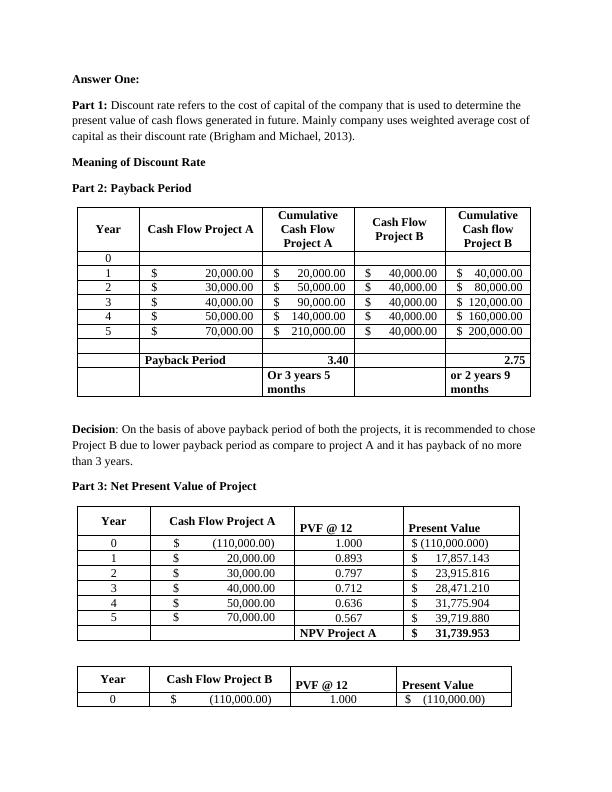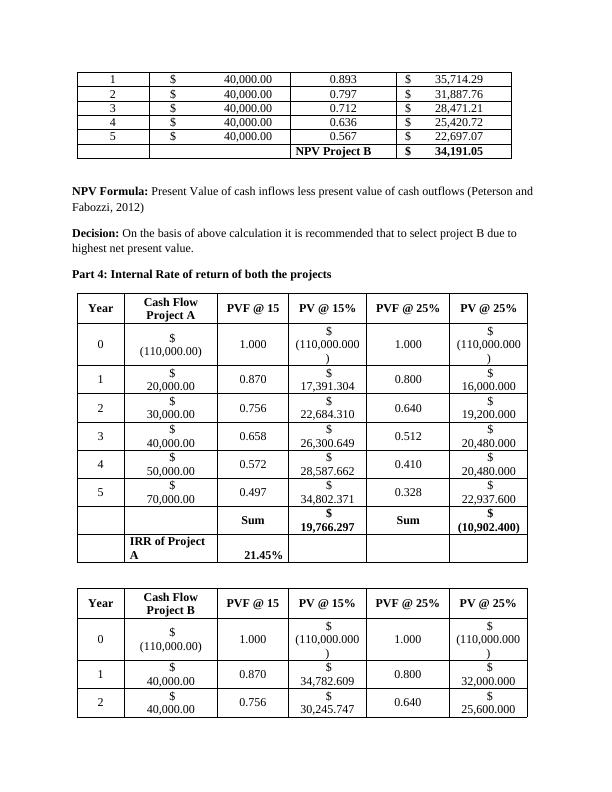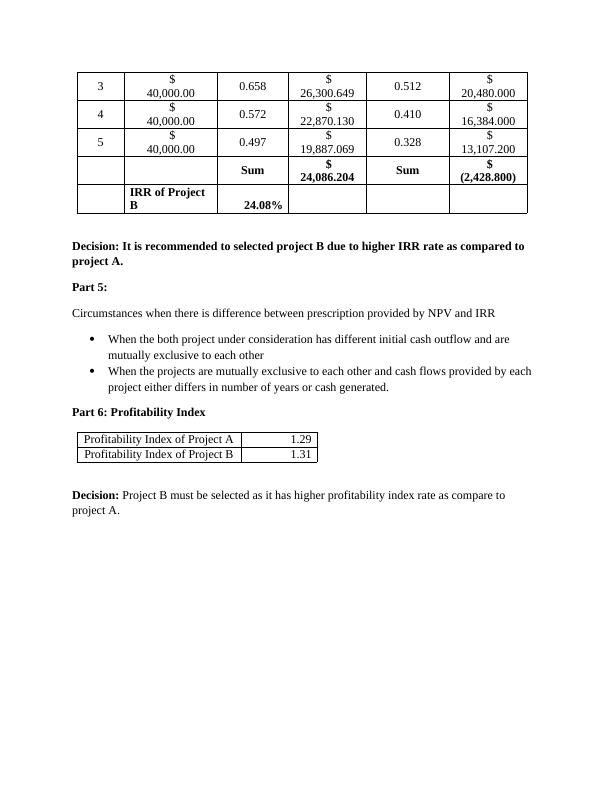Capital Budgeting: Calculation of Payback Period, NPV, IRR and Profitability Index
Added on 2023-06-05
7 Pages1151 Words393 Views
Answer One:
Part 1: Discount rate refers to the cost of capital of the company that is used to determine the
present value of cash flows generated in future. Mainly company uses weighted average cost of
capital as their discount rate (Brigham and Michael, 2013).
Meaning of Discount Rate
Part 2: Payback Period
Year Cash Flow Project A
Cumulative
Cash Flow
Project A
Cash Flow
Project B
Cumulative
Cash flow
Project B
0
1 $ 20,000.00 $ 20,000.00 $ 40,000.00 $ 40,000.00
2 $ 30,000.00 $ 50,000.00 $ 40,000.00 $ 80,000.00
3 $ 40,000.00 $ 90,000.00 $ 40,000.00 $ 120,000.00
4 $ 50,000.00 $ 140,000.00 $ 40,000.00 $ 160,000.00
5 $ 70,000.00 $ 210,000.00 $ 40,000.00 $ 200,000.00
Payback Period 3.40 2.75
Or 3 years 5
months
or 2 years 9
months
Decision: On the basis of above payback period of both the projects, it is recommended to chose
Project B due to lower payback period as compare to project A and it has payback of no more
than 3 years.
Part 3: Net Present Value of Project
Year Cash Flow Project A PVF @ 12 Present Value
0 $ (110,000.00) 1.000 $ (110,000.000)
1 $ 20,000.00 0.893 $ 17,857.143
2 $ 30,000.00 0.797 $ 23,915.816
3 $ 40,000.00 0.712 $ 28,471.210
4 $ 50,000.00 0.636 $ 31,775.904
5 $ 70,000.00 0.567 $ 39,719.880
NPV Project A $ 31,739.953
Year Cash Flow Project B PVF @ 12 Present Value
0 $ (110,000.00) 1.000 $ (110,000.00)
Part 1: Discount rate refers to the cost of capital of the company that is used to determine the
present value of cash flows generated in future. Mainly company uses weighted average cost of
capital as their discount rate (Brigham and Michael, 2013).
Meaning of Discount Rate
Part 2: Payback Period
Year Cash Flow Project A
Cumulative
Cash Flow
Project A
Cash Flow
Project B
Cumulative
Cash flow
Project B
0
1 $ 20,000.00 $ 20,000.00 $ 40,000.00 $ 40,000.00
2 $ 30,000.00 $ 50,000.00 $ 40,000.00 $ 80,000.00
3 $ 40,000.00 $ 90,000.00 $ 40,000.00 $ 120,000.00
4 $ 50,000.00 $ 140,000.00 $ 40,000.00 $ 160,000.00
5 $ 70,000.00 $ 210,000.00 $ 40,000.00 $ 200,000.00
Payback Period 3.40 2.75
Or 3 years 5
months
or 2 years 9
months
Decision: On the basis of above payback period of both the projects, it is recommended to chose
Project B due to lower payback period as compare to project A and it has payback of no more
than 3 years.
Part 3: Net Present Value of Project
Year Cash Flow Project A PVF @ 12 Present Value
0 $ (110,000.00) 1.000 $ (110,000.000)
1 $ 20,000.00 0.893 $ 17,857.143
2 $ 30,000.00 0.797 $ 23,915.816
3 $ 40,000.00 0.712 $ 28,471.210
4 $ 50,000.00 0.636 $ 31,775.904
5 $ 70,000.00 0.567 $ 39,719.880
NPV Project A $ 31,739.953
Year Cash Flow Project B PVF @ 12 Present Value
0 $ (110,000.00) 1.000 $ (110,000.00)

1 $ 40,000.00 0.893 $ 35,714.29
2 $ 40,000.00 0.797 $ 31,887.76
3 $ 40,000.00 0.712 $ 28,471.21
4 $ 40,000.00 0.636 $ 25,420.72
5 $ 40,000.00 0.567 $ 22,697.07
NPV Project B $ 34,191.05
NPV Formula: Present Value of cash inflows less present value of cash outflows (Peterson and
Fabozzi, 2012)
Decision: On the basis of above calculation it is recommended that to select project B due to
highest net present value.
Part 4: Internal Rate of return of both the projects
Year Cash Flow
Project A PVF @ 15 PV @ 15% PVF @ 25% PV @ 25%
0 $
(110,000.00) 1.000
$
(110,000.000
)
1.000
$
(110,000.000
)
1 $
20,000.00 0.870 $
17,391.304 0.800 $
16,000.000
2 $
30,000.00 0.756 $
22,684.310 0.640 $
19,200.000
3 $
40,000.00 0.658 $
26,300.649 0.512 $
20,480.000
4 $
50,000.00 0.572 $
28,587.662 0.410 $
20,480.000
5 $
70,000.00 0.497 $
34,802.371 0.328 $
22,937.600
Sum $
19,766.297 Sum $
(10,902.400)
IRR of Project
A 21.45%
Year Cash Flow
Project B PVF @ 15 PV @ 15% PVF @ 25% PV @ 25%
0 $
(110,000.00) 1.000
$
(110,000.000
)
1.000
$
(110,000.000
)
1 $
40,000.00 0.870 $
34,782.609 0.800 $
32,000.000
2 $
40,000.00 0.756 $
30,245.747 0.640 $
25,600.000
2 $ 40,000.00 0.797 $ 31,887.76
3 $ 40,000.00 0.712 $ 28,471.21
4 $ 40,000.00 0.636 $ 25,420.72
5 $ 40,000.00 0.567 $ 22,697.07
NPV Project B $ 34,191.05
NPV Formula: Present Value of cash inflows less present value of cash outflows (Peterson and
Fabozzi, 2012)
Decision: On the basis of above calculation it is recommended that to select project B due to
highest net present value.
Part 4: Internal Rate of return of both the projects
Year Cash Flow
Project A PVF @ 15 PV @ 15% PVF @ 25% PV @ 25%
0 $
(110,000.00) 1.000
$
(110,000.000
)
1.000
$
(110,000.000
)
1 $
20,000.00 0.870 $
17,391.304 0.800 $
16,000.000
2 $
30,000.00 0.756 $
22,684.310 0.640 $
19,200.000
3 $
40,000.00 0.658 $
26,300.649 0.512 $
20,480.000
4 $
50,000.00 0.572 $
28,587.662 0.410 $
20,480.000
5 $
70,000.00 0.497 $
34,802.371 0.328 $
22,937.600
Sum $
19,766.297 Sum $
(10,902.400)
IRR of Project
A 21.45%
Year Cash Flow
Project B PVF @ 15 PV @ 15% PVF @ 25% PV @ 25%
0 $
(110,000.00) 1.000
$
(110,000.000
)
1.000
$
(110,000.000
)
1 $
40,000.00 0.870 $
34,782.609 0.800 $
32,000.000
2 $
40,000.00 0.756 $
30,245.747 0.640 $
25,600.000

3 $
40,000.00 0.658 $
26,300.649 0.512 $
20,480.000
4 $
40,000.00 0.572 $
22,870.130 0.410 $
16,384.000
5 $
40,000.00 0.497 $
19,887.069 0.328 $
13,107.200
Sum $
24,086.204 Sum $
(2,428.800)
IRR of Project
B 24.08%
Decision: It is recommended to selected project B due to higher IRR rate as compared to
project A.
Part 5:
Circumstances when there is difference between prescription provided by NPV and IRR
When the both project under consideration has different initial cash outflow and are
mutually exclusive to each other
When the projects are mutually exclusive to each other and cash flows provided by each
project either differs in number of years or cash generated.
Part 6: Profitability Index
Profitability Index of Project A 1.29
Profitability Index of Project B 1.31
Decision: Project B must be selected as it has higher profitability index rate as compare to
project A.
40,000.00 0.658 $
26,300.649 0.512 $
20,480.000
4 $
40,000.00 0.572 $
22,870.130 0.410 $
16,384.000
5 $
40,000.00 0.497 $
19,887.069 0.328 $
13,107.200
Sum $
24,086.204 Sum $
(2,428.800)
IRR of Project
B 24.08%
Decision: It is recommended to selected project B due to higher IRR rate as compared to
project A.
Part 5:
Circumstances when there is difference between prescription provided by NPV and IRR
When the both project under consideration has different initial cash outflow and are
mutually exclusive to each other
When the projects are mutually exclusive to each other and cash flows provided by each
project either differs in number of years or cash generated.
Part 6: Profitability Index
Profitability Index of Project A 1.29
Profitability Index of Project B 1.31
Decision: Project B must be selected as it has higher profitability index rate as compare to
project A.

End of preview
Want to access all the pages? Upload your documents or become a member.
Related Documents
Financial Management: Concepts and Techniqueslg...
|12
|2012
|441
Capital Budgeting and Business Valuation: FIN 505 – FALL 2018lg...
|8
|1607
|81
Capital Budgeting | Assignment-1lg...
|9
|1291
|22